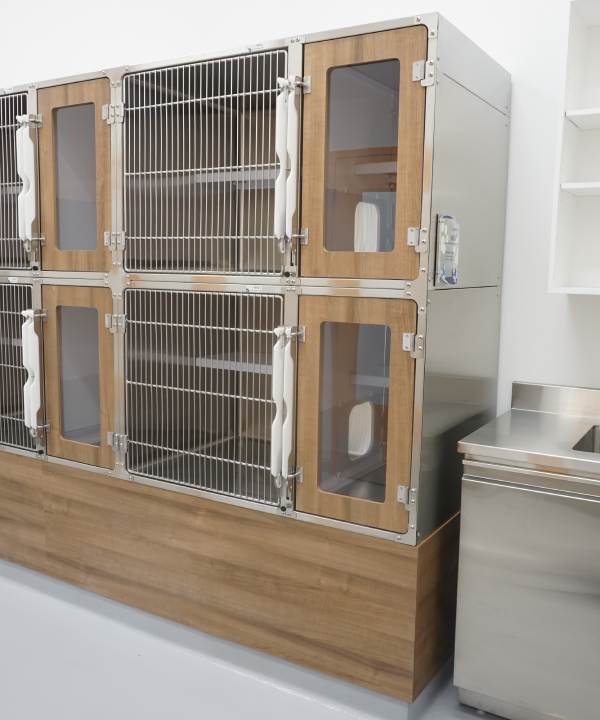Choosing a professional veterinary cage is a crucial step for clinics wishing to provide the best environment for the recovery and comfort of animals. But how do you choose from all the available options on the market? In this guide, we guide professionals through the essential criteria for making the best choice.

Materials and Durability
The choice of a cage should start by analyzing the materials with which it is made.
Stainless steel is preferred because it is durable, resistant to corrosion, and easy to clean.
These characteristics guarantee a long lifespan while maintaining a healthy and safe environment for animals.
Veterinary Cage Design and Size
A good cage must be able to mould the reality of veterinary professionals. Each establishment has different needs, making it essential to have a product that adapts to its requirements.
The chosen cage must be ergonomic, to facilitate the work of the staff and promote animal welfare.
The size of the cage must be adapted to the morphology of the animals housed in the establishment. The goal is to choose a size based on the size of the guests. I It is necessary to find the best balance between the available space, the number of animals, the duration of care, and the format of the cage.
For example, if the duration of care is long (more than a day), one can plan for an integrated litter space or a condo-type cage. This kind of cage allows for two sections within the cage (living space and space for doing their business).
It is also important to consider that the cage should not be too large for the animals staying there. It should not become a play space and thus increase the risk of injuries and slow down recovery. Playtime should be planned elsewhere than in the rest area.
Ease of Cleaning and Maintenance
The ability to maintain a clean environment is essential to ensure the health and safety of staff and patients. A cage designed with smooth surfaces and rounded angles is much easier to clean, and the risks of bacterial proliferation are minimized.
Animal Safety and Comfort
Cages must be secure to prevent escapes while avoiding the risks of injuries. The lock must prevent the animal from getting out but must be simple to unlock for staff during emergencies.
Comfort can be improved through the size of the cage, by adding soft coverings, and through adequate ventilation.
Additional Features
Innovations such as integrated heating or cooling systems, waste drawers, and modular accessories can significantly improve animal comfort and management.
Some accessories make staff work easier, for example:
- Patient identification cardholders
IV poles - Dividers (to improve cage versatility)
- Wheeled and fixed bases (ensure the module’s robustness and its movement)
- Finish panels (or cage cover panel)
All these details are crucial in choosing a professional veterinary cage. That’s why we always strive to offer the best balance based on your reality. If you are considering building a room that focuses on optimal efficiency in the long term, we can help you anticipate the standards that will make your installation perfectly suited to your establishment, while protecting it.
To improve the versatility of your clinic, we offer double cages that can be separated into two sections. Double cages allow for accommodating more guests during peak periods, or to improve the comfort of a single animal when the number of guests is less.
The type of door is an important choice that depends on the animal species and its size. Usually, there are two options available:
- Grills are designed for medium and large-sized animals. They improve ventilation and decrease the risk of damage to the door. This is the best option for dogs, as it is not material that the animal can scratch.
- Polycarbonate is the best choice for small animals. The AR2 polycarbonate we use is abrasion-resistant and very resistant to scratches, making it safe and durable.
It is also important to consider the use of the cage. Polycarbonate allows for better isolation of animals from others and prevents the spread of diseases, bacteria, and viruses (in a biosecurity context).
For animals under observation, polycarbonate is a good option that can be chosen for any type of animal. It allows for optimal vision, ensuring better monitoring by the animal health professional. For this type of animal (much less active than a healthy animal), there are fewer risks that it gets too hot inside the cage or that the door becomes soiled.
In short, choosing a professional veterinary cage should not be taken lightly. The details of the cage contribute to the quality of veterinary care provided. We hope this guide can help professionals make an informed choice.
Specializing in the manufacturing of professional veterinary equipment, Vétérinov is committed to improving animal welfare through innovative and high-quality products. Our expertise in the design and manufacturing of equipment meets the specific needs of veterinary clinics, ensuring durability, functionality, and comfort for the animals.

